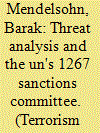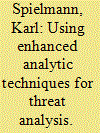| Srl | Item |
| 1 |
ID:
140863


|
|
|
|
|
| Summary/Abstract |
Because of its dynamic nature, those confronting the al-Qaeda threat must follow its evolution very closely. As demonstrated here, this task is particularly challenging when counterterrorism is carried out under the aegis of international organizations. This article explores the threat identification function of the al-Qaeda Sanctions Committee (also known as the 1267 Committee) charged with supervising the UN sanctions regime against al-Qaeda and its associates. Examination of the role of threat identification in the committee's work, and of the content of the threat analysis presented in the periodic reports of its subsidiary monitoring team, suggests the marginality of strategic threat assessment and underscores the constraints created by bureaucratic and political factors. The article also demonstrates the failure of the Committee and the monitoring team to thoroughly engage in central questions regarding al-Qaeda's nature, objectives, and organizational strategy.
|
|
|
|
|
|
|
|
|
|
|
|
|
|
|
|
| 2 |
ID:
130232


|
|
|
|
|
| Publication |
2014.
|
| Summary/Abstract |
This is intended as an instructional supplement to a methodology I proposed in my earlier article "Strengthening Intelligence Threat Analysis." 1 Through the presentation of a hypothetical case study, I hope to facilitate analysts' use of that proposed methodology by walking them through the major tests that comprise its assessment process.
Accurately determining the nature and likelihood of a threat from terrorists or state actors can be very difficult, with high costs for failure. This proposed methodology is a tool to help analysts better provide clear, timely, and well-substantiated warning to key decisionmakers. Its assessment process has three tests, which build on each other to determine the strengths and weaknesses of different possible views on a threat. The first two tests yield important interim results, affording early intelligence inputs for decisionmaking. When completed, the testing provides a numerical basis for ranking competing views, enabling more precise and transparent judgments to be made on a threat's probability than is common practice.
|
|
|
|
|
|
|
|
|
|
|
|
|
|
|
|